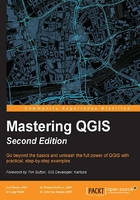
About the Authors
A former archaeologist, Kurt Menke, GISP is based out of Albuquerque, New Mexico, USA. He received a master's degree in geography from the University of New Mexico in 2000. That same year, he founded Bird's Eye View (http://www.BirdsEyeViewGIS.com) to apply his expertise with GIS technology towards ecological conservation. Along with conservation, his other focus areas are public health and education.
He is an avid open source GIS proponent since he began writing MapServer applications in 2002. He has used QGIS since 2007. Recently he also authored Discover QGIS for Locate Press. In 2015, Kurt was honored to be voted in as an OsGeo Charter Member. He is an experienced FOSS4G educator and a co-author of the GeoAcademy. In 2015 he was awarded the Global Educator of the Year Team Award by GeoForAll as part of the GeoAcademy team. Kurt authors an award winning blog on FOSS4G technologies and their use in community health mapping (http://communityhealthmaps.nlm.nih.gov/).
Special thanks go to the QGIS development team and the QGIS community for their continued dedication and work that makes QGIS what it is. I would like to thank all my co-authors for being such a joy to work with. I'd also like to acknowledge Karl Benedict for originally introducing me to the world of FOSS4G and Jeffery Cavner for his ongoing camaraderie. Finally I'd like to thank my beautiful wife, Sarah, for her steady support and encouragement.
Dr. Richard Smith Jr., GISP is an assistant professor of geographic information science in the School of Engineering and Computing Sciences at Texas A&M University – Corpus Christi. He has a PhD in geography from the University of Georgia and holds a master of science in computer science and a bachelor of science in geographic information science from Texas A&M University – Corpus Christi. Richard actively researches in cartography, systems integration, and the use of geospatial technology for disaster response. He is an advocate for FOSS4G and building FOSS4G curriculum. He is also one of the co-authors of the FOSS4G Academy (http://foss4geo.org).
He has collaborated with other writers in his field, but Mastering QGIS is his first book effort.
I would like to thank my wife and daughter for putting up with my late-night and weekend writing sessions. I would also like to thank my co-author Kurt Menke for being patient with my edits.
Outside those directly involved or affected by the writing of the book, I'd like to thank my academic and life mentors Dr. Stacey Lyle, Dr. Thomas Hodler, Dr. Gary Jeffress, and Dr. Robin Murphy for providing support and well-wishes as I work through the beginnings of my career. In addition to teaching me more than you know, you have inspired me to have the confidence to teach and write. To those of you reading this, I hope I do my mentors justice by providing a clear and useful text to assist you in Mastering QGIS.
Dr. Luigi Pirelli is a freelance software analyst and developer with a degree with honors in computer science at Bari University.
He worked for 15 years in the Satellite Ground Segment and Direct Ingestion for the European Space Agency. Since 2006, he has been involved in the GFOSS world, contributing in QGIS, GRASS, and Mapserver core, and developing and maintaining many QGIS plugins. He actively participates in QGIS Hackmeetings.
Luigi is the founder of the OSGEO Italian local GFOSS chapter. Now, he lives in Spain contributing to this GFOSS community. During the last few years, he started teaching PyQGIS, organizing training from basic to advanced level, and supporting companies to develop their specific QGIS plugins.
He is also the founder the local hackerspace group Bricolabs.cc, focused on open hardware. He likes cycling, repairing everything, and training groups on conflict resolution. Other than this book, he has also contributed to the Lonely Planet guide Cycling Italy.
A special thanks to the QGIS developer community and core developers because the project is managed in a really open way, allowing contribution from everyone.
I want to thank everyone I worked with. From every one of them I learned, and without them, I wouldn't be here making my contributions to free software and this book.
Special thanks to my friends and neighbors who helped me with my son during writing this pages.
I would like to dedicate this book to my partner and especially to my son for the patience he had seeing me hours sitting in front of a computer without playing with him.
Dr. John Van Hoesen, GISP is an associate professor of geology and environmental studies at Green Mountain College in rural west-central Vermont, USA. He earned an MS and a PhD in geology from the University of Nevada, Las Vegas, in 2000 and 2003. He is a certified GIS Professional (GISP) with a broad background in the geosciences and has used some flavor of GIS to evaluate and explore geological processes and environmental issues since 1997. John has used and taught some variants of FOSS GIS since 2003 and over the last three years has taught graduate, undergraduate, and continuing education courses using only FOSS GIS software.